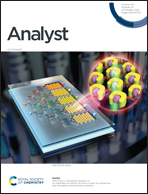A computational and experimental study of the fragmentation of l-leucine, l-isoleucine and l-allo-isoleucine under collision-induced dissociation tandem mass spectrometry†
Abstract
The isomeric amino acids L-leucine, L-isoleucine and L-allo-isoleucine, are essential to many vital biological processes and are therefore of interest to the fields of metabolomics and proteomics. Their discrimination can be problematic however due to their isomeric natue. This study demonstrates a systematic investigation of the fragmentations of L-leucine, L-isoleucine and L-allo-isoleucine in combination with a thorough theoretical rationalisation. Collision induced dissociation (CID) tandem mass spectra (MS/MS) of all three amino acids were collected under a range of different collision energies to identify spontaneous and sequential fragmentation processes. We demonstrate that the three structural isomers can be distinguished by their CID MS/MS spectra, and additional computational modelling is used to rationalise these differences.

- This article is part of the themed collection: 150th Anniversary Collection: Metabolomics


 Please wait while we load your content...
Please wait while we load your content...